Does The Canon M50 Camera Have Time Lapse Recording
Time-Lapse Movies
-
Select [
: Time-lapse movie].
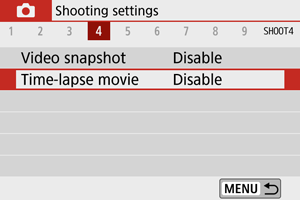
-
Select [Time-lapse].
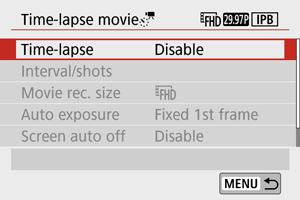
-
Select a scene.
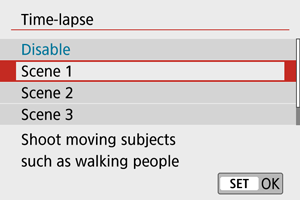
- Select a scene to suit the shooting situation.
- For greater freedom when setting the shooting interval and number of shots manually, select [Custom].
-
Set up the shooting interval.

When [Custom] is set
-
Set up the number of shots.

When [Custom] is ready
Caution
- [Playback fourth dimension] is displayed in red if the card does not take enough complimentary infinite for your specified number of shots. Although the camera can proceed recording, the recording volition stop when the card becomes full.
- [Playback time] is displayed in red if the [No. of shots] setting results in a file size exceeding four GB for a carte non formatted in exFAT (). If you keep recording in this status and the pic file size reaches 4 GB, the time-lapse movie recording volition finish.
Note
- With [Scene *], available intervals and numbers of shots are restricted, to suit the type of scene.
- For details on cards that can tape time-lapse movies, see Card performance requirements (Movie recording).
- If the number of shots is gear up to 3600, the time-lapse movie will be approx. two min. in NTSC and approx. 2 min. 24 sec. in PAL.
-
Select the desired moving-picture show recording size.

-
(3840 × 2160)
The movie is recorded in 4K quality. The aspect ratio is xvi:9.
The frame rate is 29.97 fps (
) for NTSC and 25.00 fps (
) for PAL, and movies are recorded in MP4 (
) format with ALL-I (
) compression.
-
(1920 × 1080)
The motion-picture show will be recorded in Full Loftier-Definition (Total Hard disk) quality. The aspect ratio is 16:nine.
The frame rate is 29.97 fps (
) for NTSC and 25.00 fps (
) for PAL, and movies are recorded in MP4 (
) format with ALL-I (
) compression.
-
-
Set [Auto exposure].

-
Fixed 1st frame
When taking the first shot, metering is performed to fix the exposure automatically to match the brightness. The exposure setting for the first shot will be applied to subsequent shots. Other shooting-related settings for the starting time shot will also be practical for subsequent shots.
-
Each frame
Metering is as well performed for each subsequent shot to set the exposure automatically to match the effulgence. Note that any functions such as Picture Style and white balance that are set to [Motorcar] will be set automatically for each subsequent shot.
Caution
- Meaning changes in effulgence between shots may prevent the camera from shooting at the specified interval when [Interval] is set to three sec. or less and [Automobile exposure] is set to [Each frame].
- With [Auto exposure] set to [Each frame], the ISO speed, shutter speed, and aperture value may not exist recorded in the fourth dimension-lapse movie Exif information in some shooting modes.
-
-
Gear up [Screen car off].

-
Disable
Even during time-lapse movie recording, the image will exist displayed. (The screen turns off just at the time of shooting.) Note that the screen will plow off when approx. 30 min. elapse after the shooting started.
-
Enable
Note that the screen will turn off when approx. 10 sec. expire after the shooting started.
Note
- During time-lapse movie recording, you can printing the
button to plow on/off the screen.
-
-
Set the beeper.
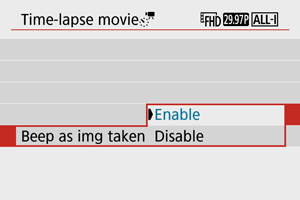
- Select [Beep as img taken].
- Gear up to [Disable] to preclude the photographic camera from beeping for each shot.
-
Check the settings.
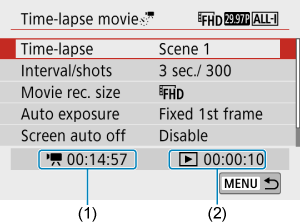
(1) Fourth dimension required
Indicates the time required to shoot the set number of shots with the set interval. If information technology exceeds 24 hours, "*** days" will be displayed.
(2) Playback time
Indicates the moving-picture show recording time (time required to play back the movie) when creating the time-lapse motion-picture show in 4K movie or Full Hard disk drive movie from the yet photos taken with the gear up intervals.
-
Close the carte.
- Printing the
push to plough off the menu screen.
- Printing the
-
Record the time-lapse movie.
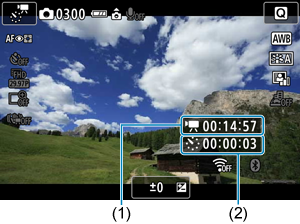
- Printing the
button and check again the "Time required (1)" and "Interval (ii)" displayed on the screen.
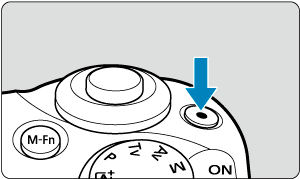
- Printing the moving picture shooting push to outset time-lapse moving-picture show recording.
- AF will not work during fourth dimension-lapse motion-picture show recording.
- "
REC" is displayed in the upper right of the screen as the time-lapse movie is recorded.
- When the set number of shots are taken, the fourth dimension-lapse movie recording ends.
- To cancel recording time-lapse movies, set [Time-lapse] to [Disable].
- Printing the
Caution
- Do not indicate the camera toward an intense calorie-free source, such as the sun or an intense bogus light source. Doing then may damage the epitome sensor or the camera's internal components.
- [
: Time-lapse movie] cannot exist set to an option other than [Disable] when the camera is connected to a figurer with the interface cablevision, or when an HDMI cable is connected.
- Movie Servo AF volition non function.
- If the shutter speed is 1/30 sec. or slower, the exposure of the moving picture may not be displayed properly (may differ from that of the resulting picture show).
- Do not zoom the lens during time-lapse movie recording. Zooming the lens may cause the image to be out of focus, the exposure to alter, or the lens abnormality correction not to function properly.
- Recording time-lapse movies under flickering light may crusade noticeable screen flickering, and images may exist captured with horizontal stripes (noise) or irregular exposure.
- Images displayed as fourth dimension-lapse movies are recorded may look different from the resulting movie (in details such as inconsistent brightness from flickering light sources, or noise from a high ISO speed).
- When recording a time-lapse movie under depression light, the paradigm displayed during shooting may look unlike from what is actually recorded in the moving picture. In such cases, the [
] icon volition blink.
- If you move the camera from left to right (panning) or shoot a moving subject during fourth dimension-lapse picture show recording, the image may await extremely distorted.
- During time-lapse flick recording, auto ability off will non take issue. Likewise, you cannot adjust the shooting function and bill of fare office settings, play back images, etc.
- Sound is not recorded for time-lapse movies.
- If the shutter speed exceeds the shooting interval (such equally for long exposures), or if a slow shutter speed is set automatically, the photographic camera may not be able to shoot at the set interval. Shooting may also be prevented past shooting intervals nearly the aforementioned as the shutter speed.
- If the next scheduled shot is not possible, it will be skipped. This may shorten the recording time of the created time-lapse flick.
- If the time information technology takes to record to the card exceeds the shooting interval due to the shooting functions set or card performance, some of the shots may non be taken with the set intervals.
- The captured images are not recorded every bit still photos. Even if yous cancel the fourth dimension-lapse movie recording after only one shot is taken, it will be recorded as a movie file.
- Set [
: Time-lapse movie] to [Disable] if you will connect the camera to a computer with the interface cablevision and use EOS Utility (EOS software). Options other than [Disable] volition prevent the camera from communicating with the computer.
- During time-lapse movie recording, the lens'southward Epitome Stabilizer volition not operate.
- Time-lapse pic recording ends if the power switch is prepare to
, and the setting changes to [Disable].
- Fifty-fifty if a flash is used, it volition not fire.
-
The following operations cancel standby for fourth dimension-lapse motion-picture show recording and switch the setting to [Disable].
- If yous start fourth dimension-lapse movie recording while the white [
] () icon is displayed, the image quality of the time-lapse movie may deteriorate. It is recommended that yous start time-lapse movie recording later on the white [
] icon disappears (camera'south internal temperature decreases).
Note
- Using a tripod is recommended.
- Taking exam shots in accelerate is recommended.
- The movie's field of view coverage for both the 4K and Full Hard disk time-lapse movie recording is approx. 100%.
- To cancel time-lapse film recording in progress, press the motion picture shooting button. The time-lapse movie shot so far will be recorded on the carte.
- If the time required for recording is more than than 24 hours just not more 48 hours, "two days" will exist indicated. If 3 or more days are required, the number of days will be indicated in 24-hr increments.
- Even if the fourth dimension-lapse moving picture'due south playback time is less than 1 sec., a movie file will still be created. In this case, "00'00"" is indicated in [Playback time].
- If the recording time is long, using the household power outlet accessories (sold separately) is recommended.
- YCbCr 4:2:0 (viii-flake) color sampling and the BT.709 colour space are used for 4K/Full Hard disk time-lapse movies.
Note
- You lot can use Wireless Remote Control BR-E1 (sold separately) to start and stop the time-lapse movie recording. Ready past setting [
: Remote control] to [Enable].
-
With Wireless Remote Command BR-E1
- Commencement, pair the BR-E1 with the camera ().
Photographic camera Status/
Remote Control Setting
(Immediate Release)
2 (2-sec. Delay)
(Movie Recording)
Recording standby As set in the Shutter Button Part for Movies setting Starts recording During fourth dimension-lapse flick recording Ends recording
Approx. Time Available for Recording Time-Lapse Movies
For guidelines on how long you can tape time-lapse movies (until the battery runs out), see Bachelor Operating Time.
Source: https://support.usa.canon.com/kb/index?page=content&id=ART178364
Posted by: shepardthalow.blogspot.com

0 Response to "Does The Canon M50 Camera Have Time Lapse Recording"
Post a Comment